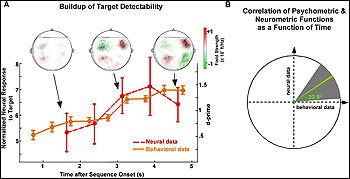 |

|
 |
(A) Normalized neural response to target rhythm, and behavioral performance, as a function of time in target task, averaged over participants. Error bars represent standard error. Insets: the MEG magnetic field distributions of the target rhythm response component for a single participant at representative moments in time (participant 10 from Figure 2B). (B) Correlation of behavioral and neural responses as a function of time. The ratio of the neural to behavioral response trends as a function of time, interpreted as a slope angle, is averaged across participants, yielding a mean slope angle of 34.3° (yellow line). Bootstrap estimates (overlying green line) and the 95% confidence intervals (gray background) confirm the positive correlation between the psychometric and neurometric buildup curves. (Source: PLoS Biology) |
|
ISR-affiliated Associate Professor Jonathan Simon (ECE) is the lead author of "Interaction between attention and bottom-up saliency mediates the representation of foreground and background in an auditory scene," an article in the latest issue of PLoS (Public Library of Science) Biology. PLoS Biology is a prestigious open-access scientific journal.
Simon's co-authors are Professor Shihab Shamma (ECE/ISR); Mounya Elhilali, a 2004 ECE Ph.D. advised by Dr. Shamma and a former ISR postdoc, now on the ECE faculty at Johns Hopkins University; and Juanjuan Xiang, a 2008 ECE Ph.D. advised by Dr. Simon, now employed by Starkey Laboratories in Minnesota.
The paper focuses on attention, the cognitive process underlying the ability to focus on specific aspects of the environment while ignoring others. By its very definition, attention plays a key role in differentiating foreground (the object of attention) from unattended clutter, or background. The authors investigate the neural basis of this phenomenon by engaging listeners to attend to different components of a complex acoustic scene. The participants' neural responses are recorded using the technique of magnetoencephalography (MEG).
The experimental findings reveal that auditory attention strongly modulates the sustained neural representation of the target signals in the direction of boosting foreground perception. This enhancement originates in auditory cortex, and occurs exclusively at the frequency of the target rhythm. The results show a strong interaction between the neural representation of the attended target with the behavioral task demands, the bottom-up saliency of the target, and its perceptual detectability over time.
Related Articles:
New book by Jeffrey Herrmann: Metareasoning for Robots
Autism Research Resonates in Hearing-Focused Project
The Falcon and the Flock
Discovering a digital biomarker for post-stroke cognitive problems
2023 BBI Seed Grants Inspire New Interdisciplinary Collaborations
Aloimonos, Sandini contribute chapter to MIT Press book, Cognitive Robotics
Abshire is part of new DARPA/SRC JUMP 2.0 Center
New system uses machine learning to detect ripe strawberries and guide harvests
Helping robots navigate to a target, around obstacles and without a map
Game-theoretic planning for autonomous vehicles
July 14, 2009
|

